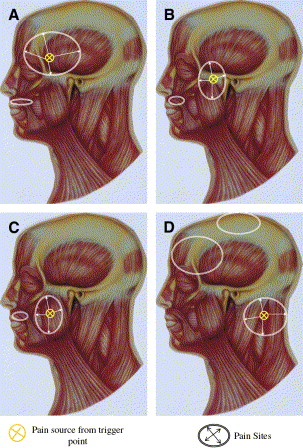Myogenous temporomandibular disorders (or masticatory myalgia) are characterized by pain and dysfunction that arise from pathologic and functional processes in the masticatory muscles. There are several distinct muscle disorder subtypes in the masticatory system, including myofascial pain, myositis, muscle spasm, and muscle contracture ( Box 1 ) .
-
Myofascial pain: repetitive strain
-
Dull aching pain in the jaw, face, ear, temples, or forehead
-
Localized tenderness (TrPs) in specific taut muscle bands with tenderness on the same side as the pain. See Fig. 1 for sites and referral patterns.
-
Duplicate the pain with palpation of the tender TrPs
-
Muscle spasm: acute overuse
-
Acute onset of pain in the jaw, face, ear, or temples at rest and in function
-
Moderate to severe acute limited range of motion due to continuous muscle contraction. In lateral pterygoid spasm, the jaw has a shift to one side with subsequent acute malocclusion that is reversible.
-
Generalized tenderness of the muscle
-
Myositis: injury or infection
-
Pain, usually continuous, in a localized muscle area following injury or infection that is increased with mandibular movement.
-
Diffuse tenderness over the entire muscle area involved
-
Moderate to severe limited range of motion
-
Swelling over muscle area involved
-
Muscle contracture: muscle fibrosis
-
Gross limited range of mandibular motion
-
Unyielding firmness on passive stretch (hard end feel)
-
Little or no pain unless the involved muscle is forced to lengthen
-
Long-term history of trauma, infection, or long period of disuse and limited range of motion
Myofascial pain is the most common muscle pain disorder . It is an acute to chronic condition that includes the presence of regional pain associated with tender areas, called trigger points (TrPs), which are expressed in taut bands of skeletal muscles, tendons, or ligaments. Although the pain occurs most often in the region over the TrP, pain can be referred to areas distant from the TrPs (eg, temporalis referring to the frontal area and masseter referring into the ear or the posterior teeth). Often, reproducible duplication of pain complaints with specific palpation of the tender area is diagnostic.
Myositis is an acute condition with localized or generalized inflammation of the muscle and connective tissue, and associated pain and swelling overlying the muscle. Most areas in the muscle are tender, with pain in active range of motion. Usually, the inflammation is due to local causes, such as overuse, excessive stretch, drug use (ie, Ecstasy), local infection from pericoronitis, trauma, or cellulitis. It also is termed delayed-onset muscle soreness in cases of acute overuse.
Muscle spasm also is an acute disorder that is characterized by a brief involuntary tonic contraction of a muscle. It can occur as a result of overstretching of a previously weakened muscle; protective splinting of an injury; as a centrally mediated phenomenon, such as Compazine-induced spasm of the lateral pterygoid muscle; or overuse of a muscle. A muscle in spasm is acutely shortened, and painful, with limited range of motion. Lateral pterygoid spasm on one side also can cause a shift of the occlusion to the contralateral side.
Muscle contracture is a chronic condition that is characterized by continuous gross shortening of the muscle with significant limited range of motion. It can begin because of factors such as trauma, infection, or prolonged hypomobility. If the muscle is maintained in a shortened state, muscular fibrosis and contracture may develop over several months. Often, pain can be minimal in the process from protection of the muscle.
Clinical presentation
The major characteristics of masticatory myalgia include pain, muscle tenderness, limited range of motion, and other symptoms, such as fatigability, stiffness, and subjective weakness. Comorbid conditions and complicating factors also are common and are discussed. Each is discussed for the different subtypes.
Pain
The common sites of pain in the masticatory system include jaw pain; facial pain; temple, frontal, or occipital headaches; preauricular pain; earache; and neck pain. Often, the pain is a constant steady dull ache that fluctuates in intensity and can be acute to chronic. The duration may vary from hours to days.
Muscle tenderness
In myofascial pain (MFP), the tenderness, termed trigger points (TrPs), is deep, localized, and about 2–5 mm in diameter. It is located in a taut band of skeletal muscle and is associated with consistent patterns of pain referral, whereas in myositis and muscle spasm, the tenderness can be generalized over the whole muscle. Myofascial TrPs are common and may be active or latent. Active TrPs are hypersensitive and display continuous pain in the zone of reference that can be altered with specific palpation. Latent TrPs display only hypersensitivity with no continuous pain. This localized tenderness is a reliable indicator of the presence and severity of MFP with manual palpation and pressure algometers ; however, the presence of taut bands seems to be a characteristic of skeletal muscles in all subjects, regardless of the presence of MFP. Palpating the active TrP with sustained deep, single-finger pressure on the taut band elicits an alteration of the pain (intensification or reduction) in the zone of reference (area of pain complaint) or causes radiation of the pain toward the zone of reference. This can occur immediately or be delayed a few seconds. The pattern of referral is reproducible and consistent with patterns of other patients who have similar TrPs ( Fig. 1 ). This enables a clinician to use the zone of reference as a guide to locate the TrP for purposes of treatment.





